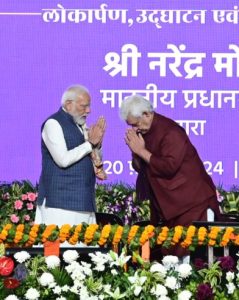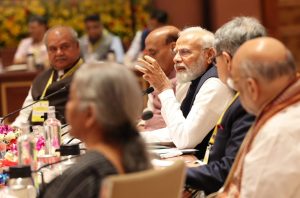A case of misleading White Paper to stake claims on gains made in UPA tenure
By Pradeep Kumar Panda
Bhubaneswar, March 1: In an extraordinary move, the Ministry of Finance presented a White Paper on the Indian Economy towards the end of the final session of the 17th Lok Sabha. The white paper was ostensibly meant to inform Parliament and the nation at large of the mess the National Democratic Alliance (NDA) government had inherited when it assumed office in 2014 and the measures the new government had taken to restore the health of the economy.
Certainly, such a discussion could have facilitated a more informed debate on the overall performance of the two governments in the run-up to the general elections later this year. Unfortunately, rather than sticking to the bare facts, the authors of the report go all out to not only belittle the gains made by the United Progressive Alliance (UPA) government during its decade in power but also go to extraordinary lengths to claim the credit for the higher growth rates achieved during the UPA rule.
The reasoning is that the Atal Bihari Vajpayee government bequeathed an economy that was growing close to eight per cent to the new UPA government which was able to sustain the higher growth mainly due to the lagged impact of the extensive reforms initiated by the previous regime and the benign global economy. However, the fact remains that the annual average gross domestic product (GDP) growth of 6.8 per cent in the two tenures of the UPA regime was around one percentage point higher than that clocked by the two NDA governments.
No doubt, some of the accusations against the inefficient management of the economy by the UPA government remain valid, especially its inability to contain inflation which rose close to double-digit levels towards the end of its tenure. Equally true are the charges of excessive lending by the banks to boost the animal spirits of the economy, which left the nation saddled with twin balance sheet deficits, an infamous legacy of the UPA government.
In fact, the overleveraged corporate sector and huge non-performing assets of the banks had triggered a sharp deceleration in private investments, which is yet to be fully reversed even after a decade of sustained efforts. But the accusations of poor financial management by the UPA government smack of malfeasance.
The fiscal consolidation achieved by the UPA government remains unmatched with the ratio of union government liabilities to GDP ratio shrinking by almost 14 percentage points to 52.2 per cent during this period. And this was achieved even while the NDA government presented relatively larger budgets, as measured by the ratio of the total budget expenditure to GDP, than the NDA government and also increased the share of funds allocated for subsidies.
This is in sharp contrast to the performance of the NDA government, which registered a five percentage point increase in the liabilities to GDP ratio to 57 per cent during its decade in power. Though this is mainly due to the substantial increase in government borrowings to combat the pandemic, the fact remains that the NDA government fumbled in reducing the total liabilities even in the six years before the calamity.
Moreover, the UPA performance on the fiscal front stands out even if one takes other parameters like direct tax mobilisation. In the case of direct taxes, the UPA increased the direct tax to GDP ratio by one and a half percentage points to 5.4 per cent of GDP during its tenure. In contrast, the huge corporate tax cuts provided by the NDA government squeezed the increase in direct tax to GDP ratio to just one percentage point, without any commensurate increase in corporate investments.
Though the UPA government’s resource mobilisation on the indirect tax front lagged behind that of the NDA, the fall in the indirect tax to GDP ratio during the former’s tenure was certainly progressive as it reduced the tax burden on the lower income groups and also helped boost consumption demand.
So, the overall trends in fiscal parameters during the UPA regime demolish the accusation that the various scams caused colossal losses to the exchequer and pushed revenue and fiscal deficits out of control. At best, the only fiscal parameter where the NDA government can claim credit is the increase in the capital expenditure to GDP ratio to above three per cent in the recent budgets.
But if one looks at the overall 10-year tenures of the UPA and NDA governments, it is clearly seen that the average capital expenditure to GDP ratio of 1.6 per cent of the UPA government was only marginally lower than that of 1.7 per cent achieved by the NDA government.
The NDA government’s performance on the external front is also equally, if not more, lacklustre. The most damning indictment is in the case of exports. During the UPA rule, India’s share in global exports more than doubled from 0.8 per cent in 2004 to 1.7 per cent in 2014. In contrast, the decade of the NDA saw India’s share in global exports declining marginally to 1.6 per cent by 2020, as per the most recent Economic Survey. Clearly, India’s share in global exports has fallen disproportionately faster than warranted by the recent global trends.
Even in the case of foreign direct investment (FDI) flows, the gains are far from impressive. Though FDI inflows have gone up from $34.5 billion in 2014 to $49.4 billion in 2022, the ratio of FDI inflows in the GDP has shrunk from 1.69 per cent to 1.42 per cent, while its share in gross fixed capital formation has reduced from 5.3 per cent to 5.1 per cent during the period. The only consolation is that India’s share in global FDI flows has moved up marginally from 2.4 per cent to 3.8 per cent between these years.
(Opinion expressed in the article solely belongs to the author)
Subscribe: youtube.com/@TheRaisinaHills
Join: https://whatsapp.com/channel/0029VaFAp9b60eBiuA8v1x0s








